Pan-Seared Duck Breast: Thermal Principles
There are generally two groups of people in this country that eat duck, those with plenty of money to buy it in restaurants and those that hunt it themselves. Duck breast and duck confit adorn the tables of the finest restaurants, while roast duck and duck sausage abound in the hunter’s kitchen. But there is no reason that you shouldn’t be cooking high-class duck breast in your own home, whether or not you hunted it yourself.
To make it well, just be sure that you render the thick layer of fat under the skin and you don’t overcook the meat! All you need is some salt, a good pan an instant-read thermometer like Thermapen® ONE, and maybe a wireless leave-in probe thermometer like RFX MEAT™.
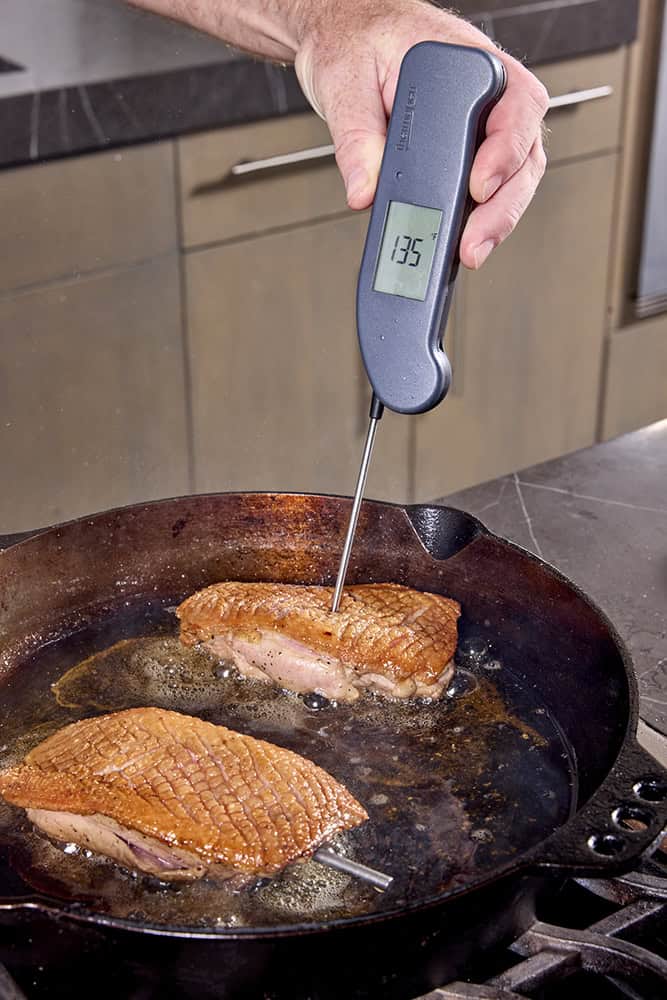
USDA Duck Breast Temp: 165°F
Chef Duck Breast Temp: 130°F
Get the tools for this cook now:
Duck doneness temps
According to the USDA, duck, like other poultry, must be cooked to an internal temperature of 165°F (74°C) to prevent foodborne illness. Now, as we’ve discussed in our writing about chicken temperatures, that is a piece of advice that will get you some dry, dry, not very tasty bird meat.
As if that weren’t bad enough, take into account the high cost of duck breast and its wonderful steak-like texture and flavor, and that USDA poultry temp recommendation starts sounding more and more constraining for duck. Would you cook a tenderloin filet steak to 165°F (74°C)? I hope not!
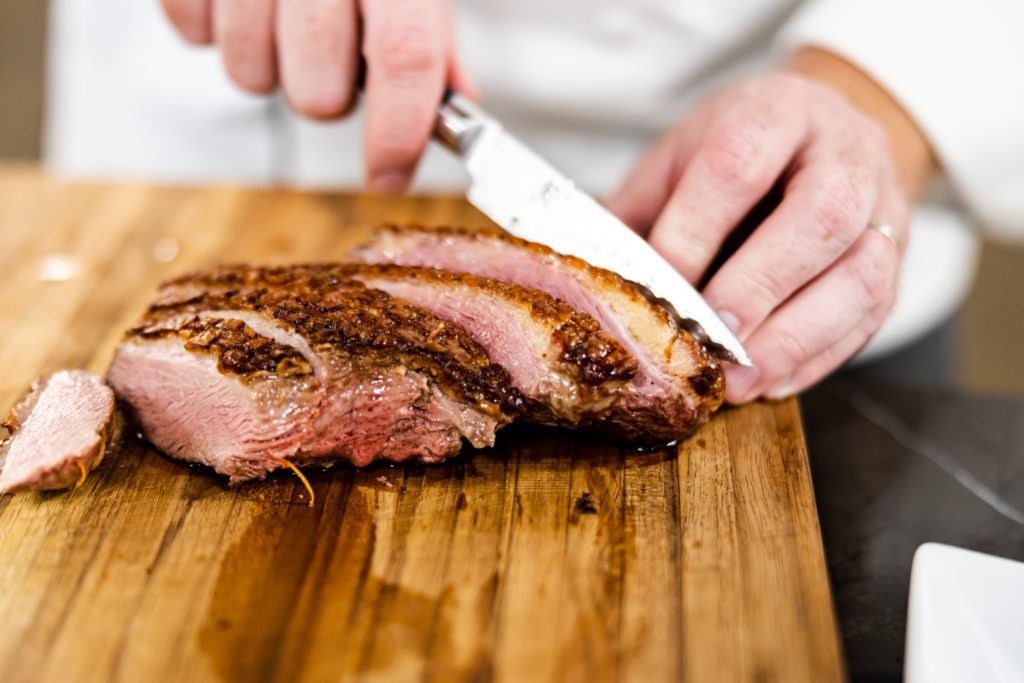
Let’s look at restaurants that serve seared duck breast: they almost all serve it medium-rare to medium. What?!? In fact, if you order your duck well done, you’ll get the same scornful look you would get if you ordered a prime cut of steak cooked well done. In truth, seared duck breast is absolutely delicious served medium-rare. It is tender and rich and juicy and delicious.
But isn’t it…unsafe?
How is medium-rare duck OK to eat?
What we fear most in poultry at lower temperatures is the pathogen Salmonella. As Harold McGee notes about Salmonella:
In the United States it’s especially prevalent…apparently thanks to the practices of industrial-scale poultry farming: recycling animal byproducts (feathers, viscera) as feed for the next generation of animals, and crowding the animals together in very close confinement, both of which favor the spread of the bacteria.
Harold McGee, On Food and Cooking, pg. 125
In many American chicken farms, such common farming practices are typically paired with water-cooling techniques in the harvesting factories, wherein the birds are soaked together in vats of cold water, swishing and washing the bacteria from one bird onto another and letting it penetrate more deeply into the tissues. Put those together and you’ve got a bacterial nightmare on your hands. That’s why you always need to properly cook your chicken!—if not all the way to 165°F (74°C), at least to its equivalent through time and temperature pasteurization (read more about that here).
BUT! Duck is, in general, another story all together. In the U.S. and Canada, ducks are generally raised more humanely and are processed with significantly more care. If you choose a good domestic supplier (our duck breasts for this cook were provided by D’Artagnan Meats and were very high quality), the risk of bacterial contamination drops exponentially. Duck meat, by virtue of its luxury status and lack of popularity, is intrinsically safer to eat.
And because duck is a migratory bird that evolved to use its breast muscles, they are structurally different than those of the chicken. They are, as mentioned above, steak-like and rich when cooked to medium rare, not squeaky and rubbery like undercooked chicken.
Is it perfectly, 100% safe to eat with absolutely no risk of infection? No. But think of that little warning you see at the bottom of almost any menu were eggs or steak or sushi are served. You know, the one that says “the risk of consuming foods that are not fully cooked…” the one you ignore when you ask for a steak done medium rare or medium or your eggs done over easy? It’s the same story here. A medium-rare duck breast is relatively safe to eat and is a treat that, to me, is worth the very minimal risk.
Rendering the fat: a slow sear
As ducks are waterfowl, they have a thick insulating layer of subcutaneous fat. When you look at a duck breast, you can see the fat under the skin, and though duck fat is delicious for use as a cooking fat, it is squidgy and chewy when it is in tissue form. To combat this, we must score the skin and fat of the duck,(not the meat, though!) and render it out.
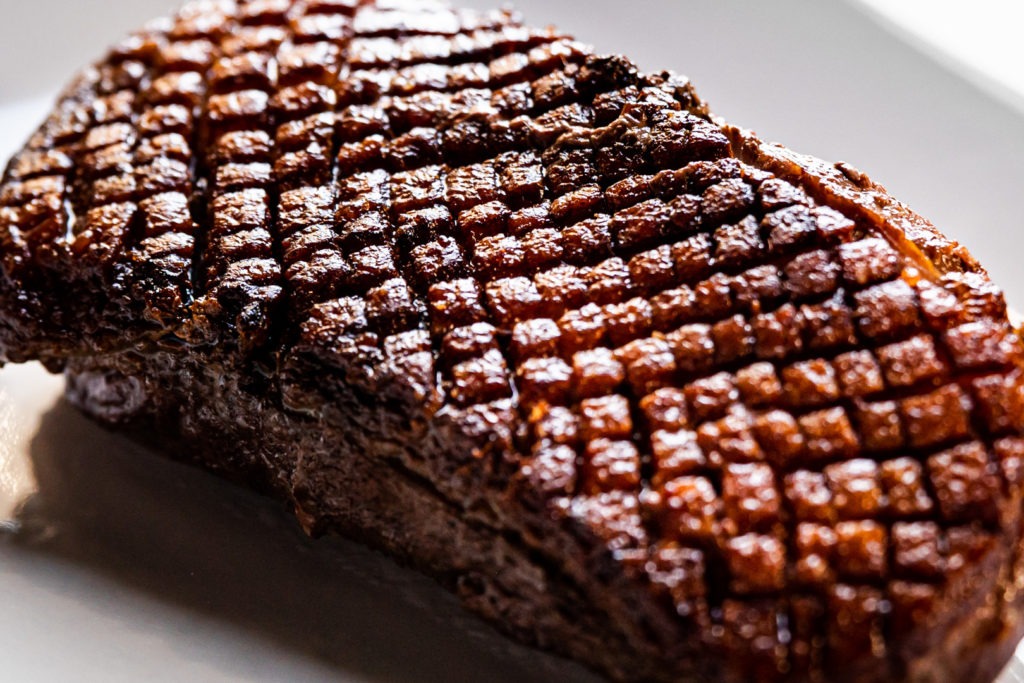
Rendering the fat without overcooking the meat is a slow-ish process that takes a little patience. The scored, salted duck breast must be placed skin-side down in a cold pan and heated over low to medium-low heat. It will not take long for the fat to start to render out. As the fat continues to render, you’ll want to keep it at a heat level that will keep it bubbling gently without popping and splattering. Every few minutes, pour the rendered fat into a heat-proof vessel to keep for later. Don’t throw it away! It is an amazing cooking fat and should be cherished.
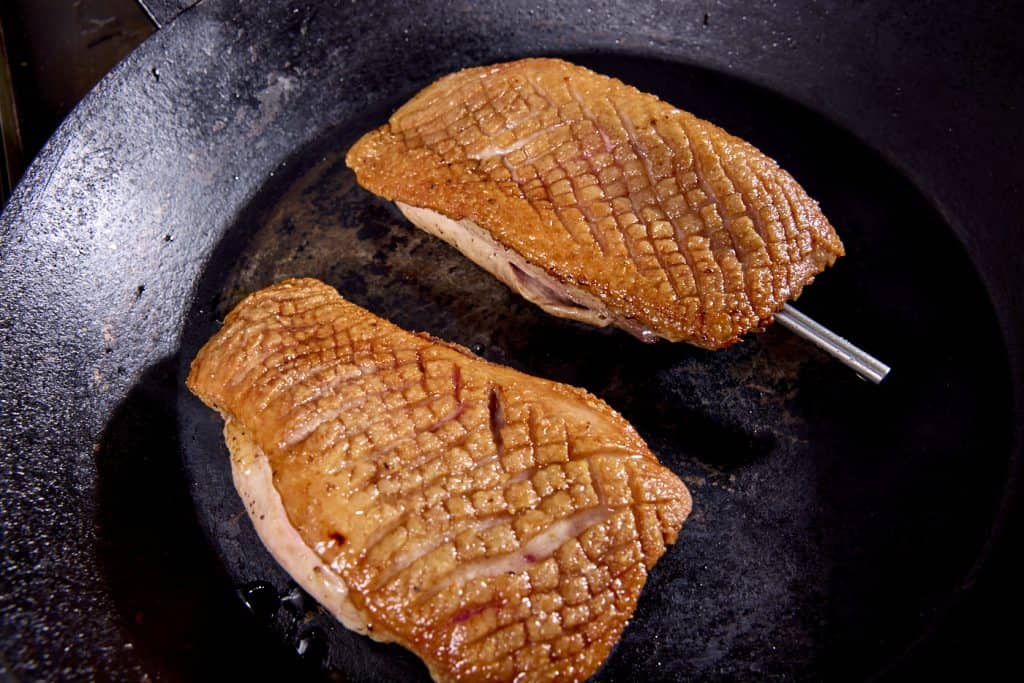
It should take about 15–20 minutes to render the fat and brown the skin. It so happens that in that amount of time, your duck breast should also get pretty close to 125°F (52°C), which is just where you want it. Use RFX MEAT and RFX GATEWAY to keep an eye on the internal temperature throughout the cook. Increase the heat to medium for a minute longer to finish browning the skin, then flip the breast over and sear the meat-side, watching for an internal temp of 130°F (54°C). Like I said, it’s a bit of a slow process, and one that can’t really be rushed. You need that long, slow render to crisp the skin and extract that golden fat, so reverse searing it or something similar won’t be as effective.
Once cooked, how you sauce it and serve it is your choice, but a classic pan sauce with fresh orange like we use below is a nice accompaniment, as are potatoes that have been blanched in salted water and then crisped in the duck fat. Yum.
If you’ve never tried properly cooked duck breast, I highly recommend it. And if you’ve been put off by the gamey/swampy flavor that often attends wild-harvested waterfowl, I’d recommend getting some farm-raised duck and giving it another try. It is a rich, elegant meat that has truly earned its place at fine restaurants. And who cooks better than a fine restaurant? You do! If you like steak, you will almost certainly like properly cooked duck breast. And with proper thermal management and monitoring, you can easily accomplish the same quality as any chef on this simple, delicious dish.
Seared Duck Breast Recipe with Orange Sauce
Ingredients
- 2 large duck breasts boneless
- Salt
Optional ingredients for a sauce
- 1/2 C white wine
- One orange zested and juiced
- About 3 Tbsp cold butter
Instructions
- Score the duck breasts neatly down to the meat, but not through the meat. You want maximum fat scoring without any chance for the meat to drain its juices out.
- Salt the duck heavily on the skin/fat side and lightly on the meat side.
- If you have one, insert and RFX MEAT probe onto the breast to track the temperature through the cook. Place the breasts skin-side down in a heavy pan, such as a cast-iron or heavy stainless steel pan.
- Turn on the heat to low-medium-low. Place another heavy pan on top of the breasts to keep them from curling up out of shape.
- Cook the breasts slowly, maintaining a gentle bubble in the rendered fat—it should be moving and bubbling but should not be popping or splattering.
- Every five or so minutes rotate the breasts in the pan for even browning. If the fat gets deep enough to start encroaching on the bare meat at the edges, pour some of it off into a container and save it for later.
- As the fat more fully renders, start to check the temperature of the breast in the center with your Thermapen. (Move the weighting-pan first, obviously.)
- When the internal temperature reaches 125°F (52°C), increase the heat under the pan to medium for about a minute to finish browning the skin.
- Flip the breast over and cook for another 1–2 minutes until the internal temperature reaches 130°F (54°C). Remove the breasts from the pan and let rest, skin-side up, on a plate.
If desired, make a pan sauce in the pan after draining the remaining fat.
- Over medium-high heat, add about a quarter of the orange’s zest and stir it in the pan, then deglaze the pan with the wine.
- Cook the wine and orange zest until the pan is almost dry.
- Add the orange’s juice and heat to a simmer.
- Remove the pan from heat and swirl the cold butter, 1 Tbsp at a time, in the pan to give it depth and texture. Taste and season with salt if necessary.
- Serve the duck with the sauce, sliced for a nice presentation.


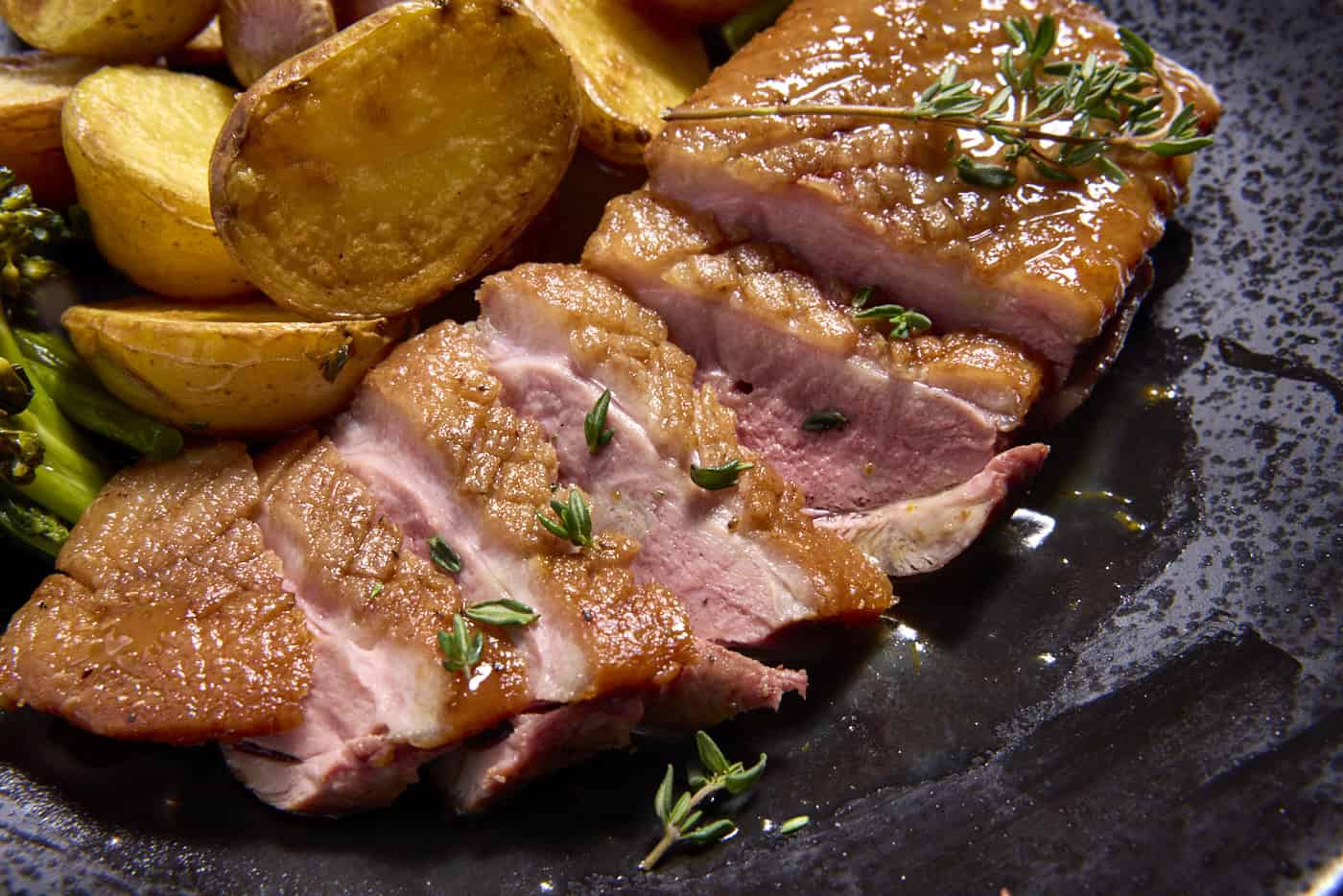

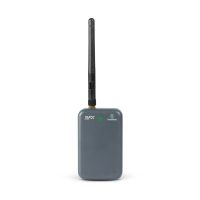
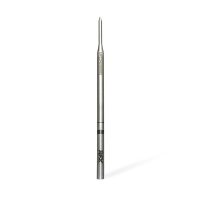
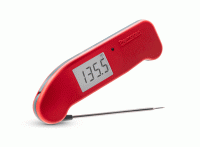
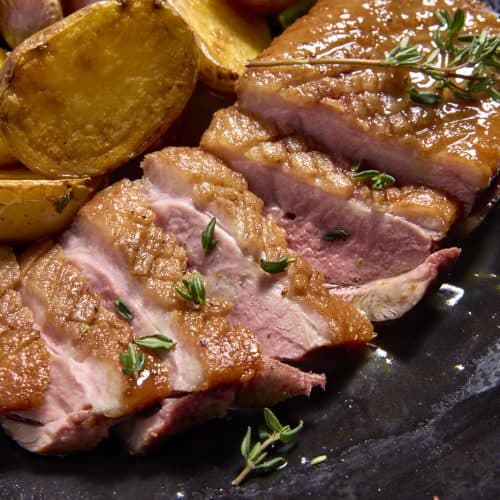
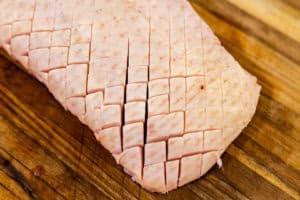
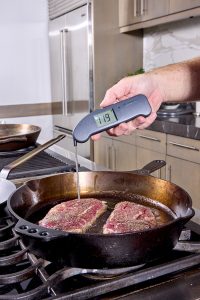
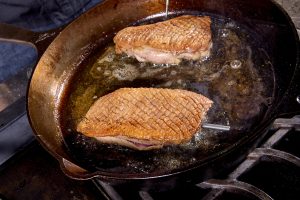
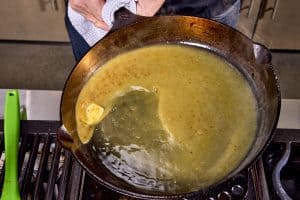
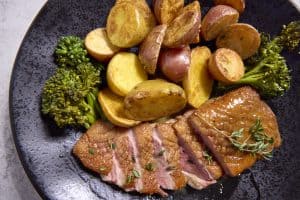
Exactly the temperature I cook mine to. I feel my sauce is better though.
1 tbsp honey
50g marmalade(orange)
1 tbsp Cointreau
1 tbsp orange juice
A handful of fresh coriander, chopped
Salt and pepper
Sounds tasty!
When I wrote that I had a Thermapen superfast (the original one) 4secs response time.I now have a Thermapen1 (1 second response time) It is amazing what a difference those few seconds make. I would recommend it to anyone.
The quoted “expert”, Harold McGee, has a BS in literature and a PhD in romantic poetry; he may have lots of experience writing about food, but apparently he has no more formal training in food safety than I have—which is none. I’ll take the USDA’s advice over his or anybody else’s personal opinion. My health is more important to me than savoring the delights of medium-rare duck, regardless of what trendy restaurants do. They serve lots of things I would never even consider eating.
It is true that his formal education is in the humanities, but he has had papers published in peer-reviewed journals such as Nature and Physics Today. His book is used as a text in food-science courses in many universities. It is well documented and draws on the research of hundreds of trained scientists.
It is worth noting that the USDA recommendations also say that steaks should be cooked to medium-well (145°F) and that eggs should be fully cooked (160°F). While we understand these risks, we often opt for a different temperature in favor of a more enjoyable experience. They also say that pork should be cooked to 145°F, but we cook pork butt to 203°F for a more delicious product.
That being said, if you don’t feel comfortable eating duck medium rare, that is fine! Cook it more to your liking, but still render that fat down so that the skin is crisp and delicious!
Terrific job of providing a clear and concise set of instructions. Thank you!
Thanks!
How would this recipe differ if there was no skin? Many hunters would just breast out the duck and have not skin
Leave as much fat as possible on the breast, though the skin is removed. Then score the fat and render it in the same way. If you remove he fat, still cook it to medium-rare, but maybe do it in a smoker or a sous-vide.
This is so true. The amount of well intentioned but badly misinformed duck temperature guidelines really throws off the hone chef. Great techniques in this. Thanks.
*home!
HI J.M
The duck at those temps would be perfectly safe. Duck does not suffer with salmonella as does chicken.Here in the UK we have more stringent rules than the rest of the world. It has been deemed by our health and safety it is safe to eat pink duck pink pork because the parasite that was in pork has now been eliminated. It was nothing to do with under
cooked meat. Also raw eggs are now safe. No salmonella. The US with their trade deal (now we have left the EU) want us to buy their chlorinated chickens. We dont want them because the US has such atrocious health standards raising poultry and game birds they have to chlorinate them. We in the UK do not have to do that. I hope J.M. you understand the different standards that exist throughout the world in terms of hygiene and animal welfare. No I’m not a veggie.
This is a very contentious issue. Salmonella may have reduced in the UK but has been replaced with Campylobacter. I started as a Chef many years ago and have since been teaching Food Safety for the past 20 odd years. Excellent arguments show the frustration Chefs have at being told by Environmental Health Officers that the FSA 70c 2min or equivalent. As Duck is a far healthier option compared to mass produced Chicken with only a small risk of Salmonella on the outside. Campylobacter can be found intrinsically in Liver Kidneys. This however would only be on the outside of the breast if at all. When rendering the fat out of the breast and subsequently frying lightly on the other side and finishing a few minutes in the oven. This will kill any remaining Bacteria. Take out and rest wrapped in a piece of greaseproof. This maximises retention of juices. You will then have a perfectly safe Medium Rare to medium Breast succulent to your choice.
A question for the Food Safety experts:
Is it true that if you hold the food at a temperature such as 130F over X amount of time you achieve the same safety result as cooking to 160F ?
Yes, sort of. Bacterial killoff is a function of both temperature AND time. The charts I have seen from the USDA put the lowest killoff temp at 136°F, which achieves the same safety as 165°F in 64-71 minutes (depending on the fat content of the meat, the fattier meat taking longer). At 140°F it takes between 28 and 34 minutes. I don’t know about 130°F though. That still fits within the standard “Temperature Danger Zone.”
As many of us now have infrared thermometers, it would be helpful to give the surface temperature of the pan in addition to the setting on the burner dial. This recipe says “Turn on the heat to low-medium-low.”, then “increase the heat under the pan to medium”.
The medium setting on one stove is often a different temperature than medium on another stove. And medium on the larger and smaller burners on the same stove are often different. I find it’s a bit of trial and error in the first few minutes of any new recipe as I adjust the heat to get the pan temperature that works.
Adjusting the burner to get a designated surface temp would be ideal.
Good point! I didn’t not check the pan temperature (for which I feel a little silly now) but I’d imagine it to be in the neighborhood of 275–300°F. That is hot enough to render the fat, but should be cool enough to not be burning/browning the skin the whole time. if you figure it out before I do, please re-comment!